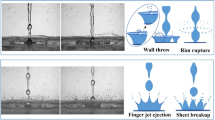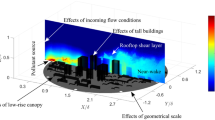Abstract
A small town close to a lead/zinc smelter was experiencing unusually high concentrations of sulfur dioxide during certain drainage flow conditions. The episodes occurred in situations where the buoyant plume rise should have been sufficient to eliminate any excessive ground level concentrations resulting from building wake effects. A field study was initiated using visible oil fog, tracer gas releases, and constant volume balloons. The resulting data revealed that a standing wave was being induced in the flow across the smelter bringing pollutants from as high as 150m agl down to 30m agl over the nearby town. The existence of the wave is attributed to the combined effects of the smelter buildings and the thermal forcing supplied by smelter operations. Data are presented characterizing the wavelike disturbance and documenting the meteorological conditions under which it occurs. A comparison is made between the simulated pollutant impacts using the tracer gas data and model predictions using the Industrial Source Complex dispersion model.
Similar content being viewed by others
References
Batchelor, G.K., 1967: An Introduction to Fluid Dynamics. Cambridge University Press, Cambridge, Great Britain.
Baumeister, T., E.A. Avollone and T. Baumeister III, editors, 1978: Mark's Standard Handbook for Mechanical Engineers. McGraw-Hill, New York, Chapter 18, page 16.
Cermak, J.E., 1976: Aerodynamics of Buildings. Annual Review of Fluid Mechanics, 8, 75–106.
Environmental Protection Agency, 1986: Guideline on Air Quality Models. EPA-450/2–78–027R. Office of Air Quality Planning and Standards, United States Environmental Protection Agency, Research Triangle Park, North Carolina 27711.
Halitsky, J., 1968: Gas Diffusion Near Buildings. Meteorology and Atomic Energy. D.H. Slade (ed) Chapter 5-5.
Hawkins, J.E. and G. Nonhebel, 1955: Chimneys and Dispersal of Smoke. Journal of the Institute of Fuel, 28, 530–545.
Houghton, D. and A. Kasahara, 1968: Nonlinear Shallow Fluid Flow Over an Isolated Ridge. Comm. Pure and Applied Math. 21, 1–23.
Hunt, J.C.R., C.J. Abell, J.A. Peterka and H. Woo, 1978: Kinematical Studies of the Flows Around Free or Surface Mounted Obstacles; Applying Topology to Flow Visualization. Journal of Fluid Mechanics, 3, Part I, 179–200.
LaVoie, R.L., 1968: A Meso-Scale Numerical Model and Lake Effect Storms. Ph.D. Dissertation, Department of Meteorology, Pennsylvania State University, University Park, Pennsylvania, May, 102pp.
Malkus, J.S. and M.E. Stern, 1953: The Flow of a Stable Atmosphere over a Heated Island. Journal of Meteorology, 10, 30–41.
Petersen, R.L. and M.A. Ratcliff, 1986: Evaluation of Modifications to the Plume Rise Algorithms in the Industrial Source Complex Model. Prepared for the American Petroleum Institute, 1220 L Street, Washington, D.C.
Schulman, L.L., S.R. Hanna and D.W. Heinhold, 1985: Evaluation of Proposed Downwash Modifications to the Industrial Source Complex Model. Prepared for the American Petroleum Institute, 1220 L Street, Washington, D.C.
Spangler, T.C., 1972: Dynamically Induced Meso-Scale Variations of the Urban Mixing Layer Depth. Report No. AR104, Environmental Protection Agency Grant R-800875, Department of Atmospheric Resources, University of Wyoming, Laramie, Wyoming, 30pp.
Spangler, T.C. and R.A. Dirks, 1974: Mesoscale Variations of Urban Mixing Height. Boundary Layer Meteorology, 6, 423–441.
Spelman, M.J., 1969: Response of the Atmosphere to the Surface Features of a Tropical Island, Part II, Report No. 15, National Science Foundation Grant GA-3956, Pennsylvania State University, University Park, Pennsylvania, 73–131.
Stern, M.E., and J.S. Malkus, 1953: The Flow of a Stable Atmosphere Over a Heated Island, Journal of Meteorology, 10, 105–119.
Sutton, O.G., 1960: Discussion before the Institute. Journal of the Institute of Fuel, 33, page 495.
Author information
Authors and Affiliations
Rights and permissions
About this article
Cite this article
Spangler, T.C., Schanot, A.J. A standing wave in stable drainage flow induced by a small industrial facility. Boundary-Layer Meteorol 41, 319–331 (1987). https://doi.org/10.1007/BF00120448
Issue Date:
DOI: https://doi.org/10.1007/BF00120448




